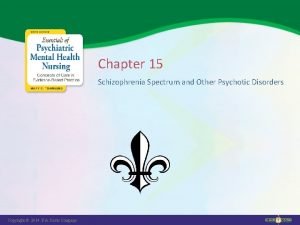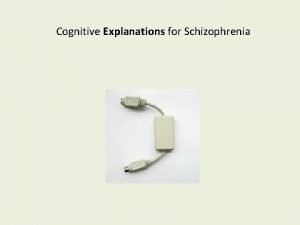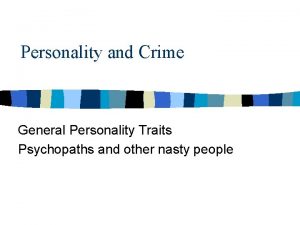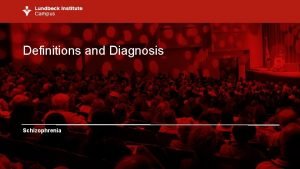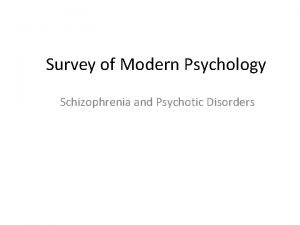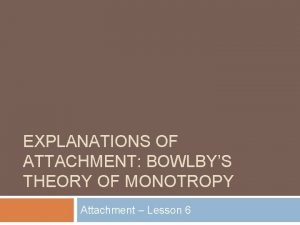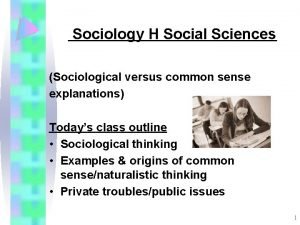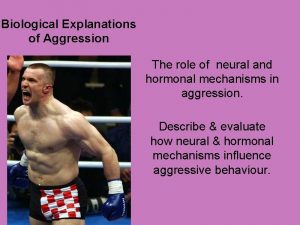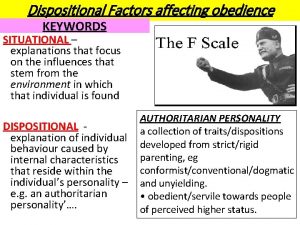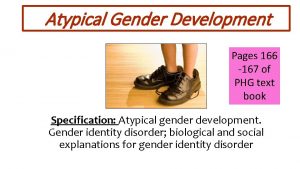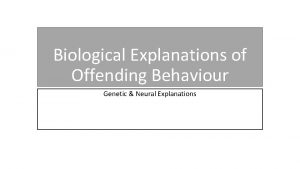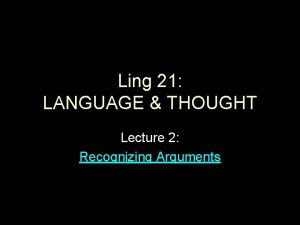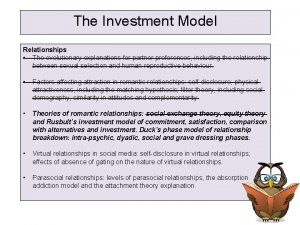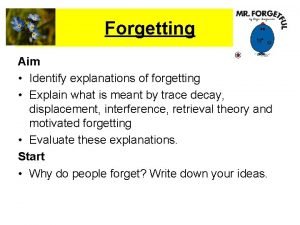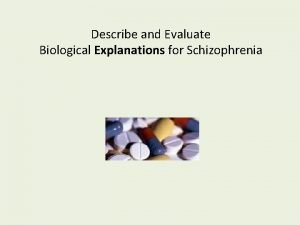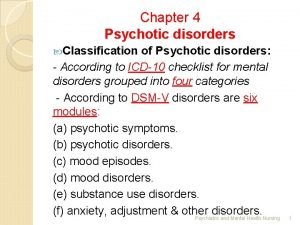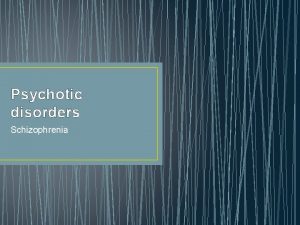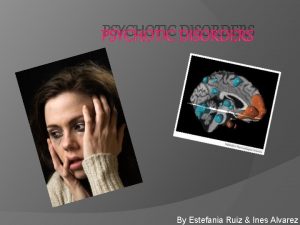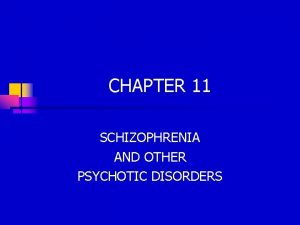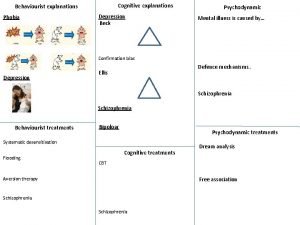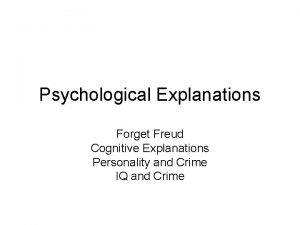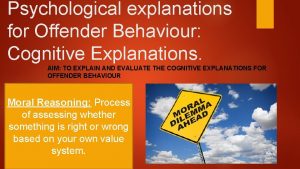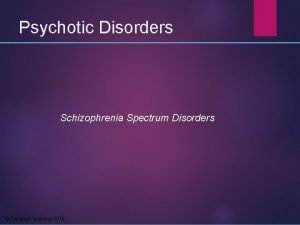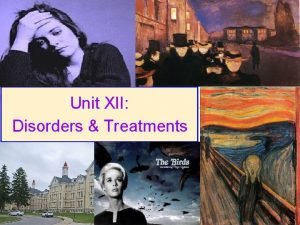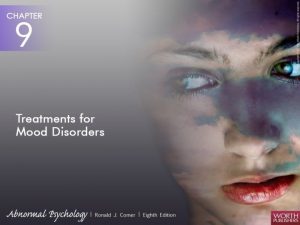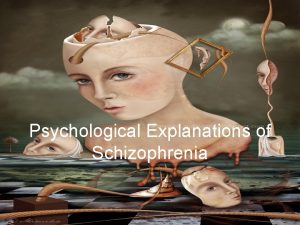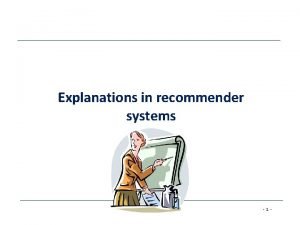Cognitive Explanations for Psychotic disorders Cognitive Treatments for



















- Slides: 19

Cognitive Explanations for Psychotic disorders Cognitive Treatments for Psychotic Disorders

Learning Outcomes • Outline the cognitive explanations for Schizophrenia • Explore the cognitive reasons for Psychotic symptoms • Explore and evaluate the scientific model of delusional thinking • Assess the effectiveness of cognitive treatments for Schizophrenia • Revision tasks

Cognitive Explanation • Hemsley (1993) suggested schizophrenics cannot distinguish between information that is already stored and new incoming information. As a result, schizophrenics are subjected to sensory overload and do not know which aspects of a situation to attend to and which to ignore. • When schizophrenics first hear voices and experience any other worrying sensory experiences, they turn to their friends and relatives to confirm the validity of what they are experiencing. Some people fail to confirm the reality of these experiences, so the schizophrenic comes to believe they must be hiding the truth. • Individuals then begin to reject feedback from those around them and develop delusional beliefs that they are being manipulated and persecuted. • Yellowlees et al have developed a curious treatment, where patience watch a machine that produces virtual hallucinations, such as hearing the television tell you to kill yourself or one person’s face morphing into another’s. This is to show schizophrenics that their hallucinations are not real, that disbelieving others is a consequence of madness. • The role of biological factors is acknowledged in this explanation – it says that the condition has always existed, but is worsened by those around them


Evaluation of Cognitive Approach Focuses on the current cognitions Plenty of research into the idea Influential and popular model Includes biological and the psychological Empowers the individual to change Ignores the environmental influences Unscientific Blaming the individual can make the disorder worse Is thinking irrational? Which is the cause? Which is the effect?

Let’s remind ourselves of the Symptoms (Behavioural Outputs) • POSITIVE SYMPTOMS – TYPE 1 – Distortion of normal function Delusions, hallucinations, disorganised speech, under the control of an alien force, disordered thinking • NEGATIVE SYMPTOMS – TYPE 2 – Lack of normal function Apathy, no emotion, flat effect, social withdrawal, Alogia (Lack of Speech)

Maher Model Task Evaluation • • approach bias application deterministic individual versus situational explanations

Cognitive Treatment Sensky et al. (2000) Aim • To compare cognitive behavioural therapy (CBT) with non-specific befriending interventions for patients with schizophrenia Design • A randomized controlled design. • Patients were allocated to one of two groups: – a cognitive behavioural therapy group. – a non-specific befriending control group.

Participants • 90 patients. – 57 from clinics in Newcastle, Cleveland Durham and 33 from London. They had diagnoses of schizophrenia that had not responded to medication. – Aged 16– 60 years. Procedure • • • Patients were allocated to one of two groups. Both interventions were delivered by two experienced nurses who received regular supervision. Patients were assessed by blind raters – at baseline. – after treatment (lasting up to 9 months). – at a 9 -month follow-up evaluation. • • • They were assessed on measures including the Comprehensive Psychiatric Rating Scale, the Scale for Assessment of Negative Symptoms, plus a depression rating scale. Patients continued to receive routine care throughout the study. The patients received a mean of 19 individual treatment sessions over 9 months.

Cognitive behavioural therapy condition • A normal routine of CBT was used: – initially engaging with patient. – examining antecedents of psychotic disorder. – developing a a reason for the behaviour. – treatment of other disorders such as depression.

CBT Strategies Used • Specific techniques for positive symptoms of schizophrenia were used: – critical analysis of beliefs about auditory hallucinations. – patients were helped to change their beliefs. – patients taught coping strategies to deal with the voices. • Delusions and thought disorders were also addressed using cognitive strategies.

What is CBT? • Cognitive behavioural therapy (CBT) is based on the idea that most unwanted thinking patterns, and emotional and behavioural reactions are learnt over a long period of time. The CBT approach to treatment differs slightly from conventional CBT methods. The aims of this therapy are as follows: • To challenge and modify delusory beliefs • To help the patient to identify delusions • To challenge those delusions by looking at evidence • To help the patient to begin to test the reality of the evidence • • • For example, you may be taught to recognize examples of delusional thinking in yourself. You may then receive help and advice about how you can avoid acting on these thoughts. Most people will require between eight to 20 sessions of CBT over the space of six to 12 months. CBT sessions usually last for about an hour. This type of treatment has been shown to be effective for reducing the positive symptoms of schizophrenia, for reducing relapse and for enhancing recovery when schizophrenia is diagnosed early.

Befriending condition • The patients had the same time allocation at the same intervals as patients in the CBT condition. • The therapists were empathic and non-directive. • There was no attempt at therapy: – The sessions focused on hobbies, sports and current affairs.

Findings • Both interventions resulted in significant reductions in positive and negative symptoms and depression. • After treatment there was no significant difference between the two groups. • At the nine-month follow-up evaluation, patients who had received cognitive therapy showed greater improvements on all measures. – They had improved, while the befriending group had lost some of the benefits.

Conclusions • Cognitive behavioural therapy is effective in treating negative as well as positive symptoms in schizophrenia resistant to standard antipsychotic drugs. • Its efficacy is sustained for at least nine months. Evaluate the research: 1. 2. 3. 4.

Evaluation of CBT for Schizophrenia Shown to be incredibly effective Not very rational to teach patients to see life through rose coloured spectacles Doesn’t work for everybody

Learning Outcomes • Outline the cognitive explanations for Schizophrenia • Explore the cognitive reasons for Psychotic symptoms • Explore and evaluate the scientific model of delusional thinking • Assess the effectiveness of cognitive treatments for Schizophrenia • Revision tasks

Homework Apply your knowledge: • You have a friend that you believe has schizophrenia. You have been asked to explain to them why they might have schizophrenia. They also ask you about which treatments you would recommend. Which explanations / treatments would you share with them? Are there any that you would leave out? • You have a friend that is suffering from stress, which appears to be having a knock on effect on their behaviour. You have been asked to explain to them why they might have stress and how and why it is impacting on their health. They also ask you about what management strategies you would recommend. Which causes / treatments would you share with them? Are there any that you would leave out?

Potential Exam Questions • • Describe two explanations one Disorder (10 marks) Evaluate explanations of Schizophrenia (15 marks) “Psychologists believe that Schizophrenia can be explained solely by biological factors” • Discuss this claim with reference to the above quotation. (10 Marks) • Describe and evaluate at least two issues in classifying or diagnosing schizophrenia (15 marks) • Explain issues relating to classifying schizophrenia as a mental disorder (10 marks) • Discuss two explanations of schizophrenia from different perspectives in psychology (15 marks) • • Describe the clinical characteristics of Schizophrenia (10 marks) Explain and evaluate issues relating to the diagnosis of Schizophrenia as a mental disorder (15 marks) • • Discuss the extent to which biological therapies can be used to treat Schizophrenia (15 marks) Describe and evaluate two psychological explanations of Schizophrenia (15 marks)
 Looseness of association example
Looseness of association example Cognitive explanations of schizophrenia
Cognitive explanations of schizophrenia Traits of a sociopath
Traits of a sociopath Schizophreniform disorder icd-10
Schizophreniform disorder icd-10 Types of delusion
Types of delusion Psychosis and neurosis
Psychosis and neurosis Monotropy
Monotropy Outline and compare two explanations for offending 16 marks
Outline and compare two explanations for offending 16 marks Examples of common sense and sociological explanations
Examples of common sense and sociological explanations Biological explanations of aggression
Biological explanations of aggression Situational factors affecting obedience
Situational factors affecting obedience Gender dysphoria biological explanations
Gender dysphoria biological explanations Neural explanations of offending behaviour
Neural explanations of offending behaviour Arguments and explanations
Arguments and explanations Dust bowl migration map
Dust bowl migration map Outline an evolutionary explanation for partner preferences
Outline an evolutionary explanation for partner preferences Motivational forgetting
Motivational forgetting Lenin political cartoon
Lenin political cartoon Biological explanations of schizophrenia
Biological explanations of schizophrenia Cognitive and non cognitive religious language
Cognitive and non cognitive religious language
